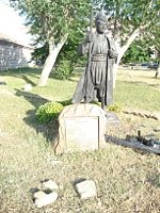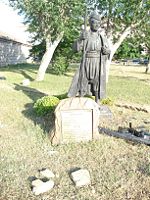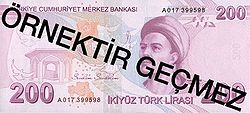
Yunus Emre
Encyclopedia

Poetry
Poetry is a form of literary art in which language is used for its aesthetic and evocative qualities in addition to, or in lieu of, its apparent meaning...
and Sufi
Sufism
Sufism or ' is defined by its adherents as the inner, mystical dimension of Islam. A practitioner of this tradition is generally known as a '...
mystic
Mysticism
Mysticism is the knowledge of, and especially the personal experience of, states of consciousness, i.e. levels of being, beyond normal human perception, including experience and even communion with a supreme being.-Classical origins:...
. He has exercised immense influence on Turkish literature
Turkish literature
Turkish literature comprises both oral compositions and written texts in the Turkish language, either in its Ottoman form or in less exclusively literary forms, such as that spoken in the Republic of Turkey today...
, from his own day until the present. Because Yunus Emre is, after Ahmet Yesevi and Sultan Walad
Sultan Walad
Baha al-Din Muhammad-i Walad , more popularly known as Sultan Walad , was the eldest son of Jalal Al-Din Rumi, Persian poet and Sufi, and one of the founders of the Mawlawiya order.-Life and Impact:...
, one of the first known Turkish poets to have composed works in the spoken Turkish of his own age and region rather than in Persian or Arabic, his diction remains very close to the popular speech of his contemporaries in Central and Western Anatolia
Anatolia
Anatolia is a geographic and historical term denoting the westernmost protrusion of Asia, comprising the majority of the Republic of Turkey...
. This is also the language of a number of anonymous folk-poets, folk-songs, fairy tales, riddles (tekerlemeler), and proverbs.
Like the Oghuz
Oghuz languages
The Oghuz languages, a major branch of the Turkic language family, are spoken by more than 110 million people in an area spanning from the Balkans to China.-Linguistic features:...
Book of Dede Korkut
Book of Dede Korkut
The Book of Dede Korkut, also spelled as Dada Gorgud, Dede Qorqut or Korkut-ata , is the most famous epic stories of the Oghuz Turks The stories carry morals and values significant to the social lifestyle of the nomadic Turks and their pre-Islamic beliefs...
, an older and anonymous Central Asia
Central Asia
Central Asia is a core region of the Asian continent from the Caspian Sea in the west, China in the east, Afghanistan in the south, and Russia in the north...
n epic, the Turkish folklore that inspired Yunus Emre in his occasional use of tekerlemeler as a poetic device had been handed down orally to him and his contemporaries. This strictly oral tradition continued for a long while.
Following the Mongolian
Mongol Empire
The Mongol Empire , initially named as Greater Mongol State was a great empire during the 13th and 14th centuries...
invasion of Anatolia
Anatolia
Anatolia is a geographic and historical term denoting the westernmost protrusion of Asia, comprising the majority of the Republic of Turkey...
facilitated by the Sultanate of Rûm
Sultanate of Rûm
The Sultanate of Rum , also known as the Anatolian Seljuk State , was a Turkic state centered in in Anatolia, with capitals first at İznik and then at Konya. Since the court of the sultanate was highly mobile, cities like Kayseri and Sivas also functioned at times as capitals...
's defeat at the 1243 Battle of Köse Dağ
Battle of Köse Dag
The Battle of Köse Dağ was fought between the Seljuk Turks of Anatolia and the Mongols on June 26, 1243 at the defile of Köse Dağ, a location between Erzincan and Gümüşhane in northeast Anatolia, modern Turkey, and ended in a decisive Mongol victory....
, Islamic mystic literature thrived in Anatolia, and Yunus Emre became one of its most distinguished poets. Poems of Sultan Yunu Emre — despite being fairly simple on the surface — evidence his skill in describing quite abstruse mystical concepts in a clear way. He remains a popular figure in a number of countries, stretching from Azerbaijan
Azerbaijan
Azerbaijan , officially the Republic of Azerbaijan is the largest country in the Caucasus region of Eurasia. Located at the crossroads of Western Asia and Eastern Europe, it is bounded by the Caspian Sea to the east, Russia to the north, Georgia to the northwest, Armenia to the west, and Iran to...
to the Balkans
Balkans
The Balkans is a geopolitical and cultural region of southeastern Europe...
, with seven different and widely dispersed localities disputing the privilege of having his tomb within their boundaries.
His poems, written in the tradition of Anatolian folk poetry
Turkish folk literature
Turkish folk literature is an oral tradition deeply rooted, in its form, in Central Asian nomadic traditions. However, in its themes, Turkish folk literature reflects the problems peculiar to a settling people who have abandoned the nomadic lifestyle...
, mainly concern divine love as well as human destiny:
Yunus Emre's portrait is depicted on the reverse
Obverse and reverse
Obverse and its opposite, reverse, refer to the two flat faces of coins and some other two-sided objects, including paper money, flags , seals, medals, drawings, old master prints and other works of art, and printed fabrics. In this usage, obverse means the front face of the object and reverse...
of the Turkish 200 lira
Turkish lira
The Turkish lira is the currency of Turkey and the de facto independent state of the Turkish Republic of Northern Cyprus. The lira is subdivided into 100 kuruş...
banknote issued in 2009.


